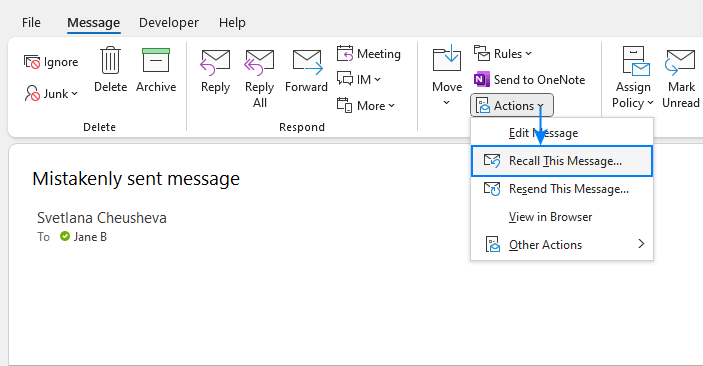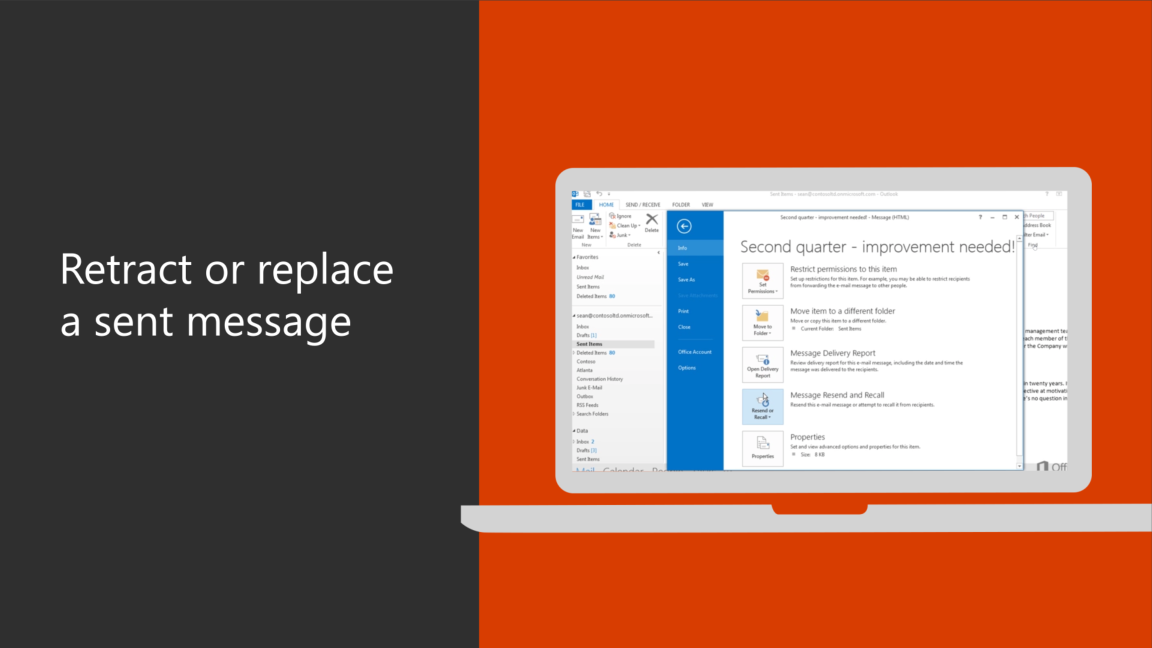Recall An Email In Office 365

The easiest (probably only way) to do a proper recall is from a full Outlook 2010+ client, while logged in as the user. Then just open the sent email, and them Message tab - Actions - Recall message. More Info: Recall or replace an email message that you sent. There's no way to recall a message via Outlook Web Access at this time (that I'm. One of my user has sent an email to internal users and external users. He is using Mac Pro, He is using outlook, is it possible to recall an email on MAC, is this feature available to recall email available in MAC and also Please correct me on this, as per my understanding if the email is read by the internal recipient, email cannot be recalled and when email is sent to external users. Your work email system is Office 365 or conventional on premises Exchange; The accidental email is not read by the unintended recipient yet. In these circumstances, you can initiate the recall. Steps: In Outlook, go to Sent Items folder, find the email you intend to recall, double click, open it. Make sure the ribbon is showing Message tab. In this article. Email revocation is offered as part of Office 365 Advanced Message Encryption. Office 365 Advanced Message Encryption is included in Microsoft 365 Enterprise E5, Office 365 E5, Microsoft 365 E5 (Nonprofit Staff Pricing), Office 365 Enterprise E5 (Nonprofit Staff Pricing), and Office 365 Education A5.If your organization has a subscription that does not include Office 365. You can recall an email message in Outlook Exchange if the recipient has yet to open it. To recall a message in Outlook, you'll need to access the Actions menu from the 'Message' tab after locating.
Outlook allows you to cancel (recall) messages that you have sent to other Outlook users. However, this feature is not available in OWA (Outlook Web App). This feature can be useful if you send a message and then you discover errors in the message and want to prevent the recipient from reading it. However, the Recall feature is somewhat limited due to the following reasons:
Recall Email Office 365 Administrator
- You can only recall messages from recipients who are currently logged onto the network and using Outlook.
- You can only recall messages that have not been read or moved out of the recipient's Inbox.
- When you attempt to recall a message, a recall notification appears in the recipient's Inbox and remains there while the recall process is taking place. If the recipient has the Outlook Inbox open, this notification may prompt them to immediately open the message you are attempting to recall.
- The recall process can take several minutes, during which time the recipient can see the recall notice in their Inbox and can open and read the message you are attempting to recall.
To recall a message, open your Sent Items folder, display the message and click on File | Resend or Recall | Recall This Message.
Topics Map > Office 365 > Outlook
Topics Map > Office 365 > General
With message recall, a message that you sent is retrieved from the mailboxes of the recipients who haven't yet opened it. you can also substitute a replacement message. For example, if you forgot to include an attachment, you can try to retract the message, and then send a replacement message that has the attachment.
Message recall is available after you click Send and is available only if the recipient has an Exchange account within the same organization.
To recall and replace a message

Recall An Email In Office 365

Recall Email Outlook 2016
- In the folder pane, choose the Sent Items folder.
- Open the message that you want to recall. You must double-click to open the message. Selecting the message so it appears in the reading pane won't allow you to recall the message.
- Under the Message tab, choose Actions > Recall This Message.
- Click Delete unread copies of this message or Delete unread copies and replace with a new message, and then click OK.
- If you're sending a replacement message, compose the message, and then click Send.
How To Recall An Email In Office 365 Outlook 2016
Action | Result |
You send a message to someone. You recall the original message and replace it with a new one. On the recipient's computer, under Tracking, the Automatically process requests and responses to meeting requests and polls check box is selected. NOTE: To view this setting, File > Options > Mail. Scroll to the Tracking section. | Both the original message and the recall message are received in the recipient's Inbox. Assuming the original message hasn’t been read, the original message is deleted and the recipient is informed that you, the sender, deleted the message from his or her mailbox. NOTE: If the original message is marked as read (viewing in the Reading Pane isn’t reading in this scenario) when the recall message is processed, the recipient is informed that you, the sender, want to delete the message. However, the message remains in the recipient's Outlook folder. |
You send a message to someone. You recall the original message and replace it with a new one. On the recipient's computer, under Tracking, the Automatically process requests and responses to meeting requests and polls check box isn’t selected. NOTE: To view this setting, File > Options > Mail. Scroll to the Tracking section. | Both the original message and the recall message are received in the recipient's Inbox. On the recipient's computer, one of the following results occurs:
NOTE: If the original message is marked as read (viewing in the Reading Pane isn’t reading in this scenario) when the recall message is processed, the recipient is informed that you, the sender, want to delete the message. However, the message remains in the recipient's Outlook folder. |
You send a message to someone. You recall the original message and replace it with a new one. On the recipient's computer, either by rule or by an action of the recipient, the original message is moved out of the Inbox to another folder and the recall message remains in the Inbox (or it is moved to another folder also). | If the recall message and the original message exist in separate folders, the recipient receives a message that states a recall attempt failed. This occurs regardless of the Outlook configurations and the read status of the message. The original message and the new message are both available to the recipient. |
You send a message to someone. You recall the original message and replace it with a new one. On the recipient's computer, either by rule or by an action of the recipient, both messages are moved to the same folder. This results in behavior similar to what occurs when Outlook isn’t configured to automatically process messages. | On the recipient's computer, one of the following results occurs:
|
You send a message to a public folder. You recall the original message and replace it with a new one. | One of the following results occurs:
If a user who has any other public folder rights opens the recall message, the recall fails, and the user receives a message that states the recall failed. Both the old and new messages remain in the public folder.
|

For more information, please visit the Office Help & Training site.
If you have any questions, come by the Help Desk at Hardman & Jacobs Undergraduate Learning Center Room 105, call 646-1840, or email us at help@nmsu.edu.